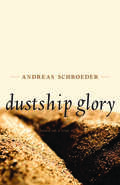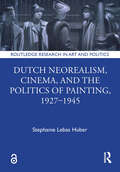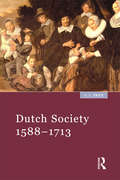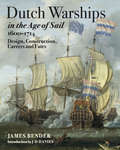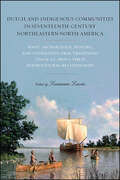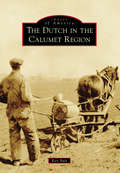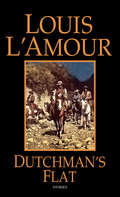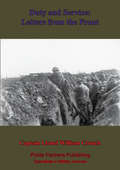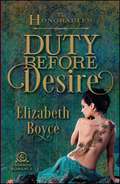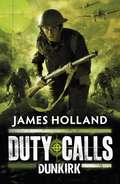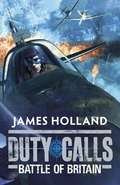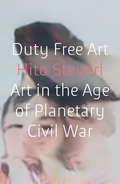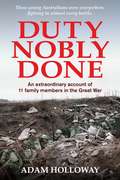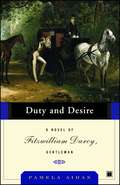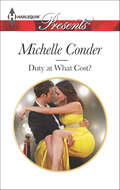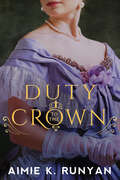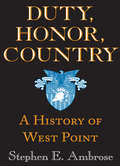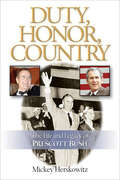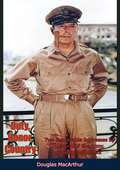- Table View
- List View
Dustship Glory
by Don Kerr Andreas SchroederIn this new edition of a prairie classic, Andreas Schroeder fictionalizes the true story of Tom Sukanen's wild scheme to build an ocean-going ship in the middle of a wheat field in Saskatchewan. Set during the hardships of the "Dirty Thirties," Dustship Glory presents us with Sukanen's mythic effort to escape both the drought and pestilence of his time, as well as his own personal struggle to be free. Featuring an illuminating foreword by beloved Saskatoon writer Don Kerr, Dustship Glory will provide Canadian and international audiences alike with the opportunity to reacquaint themselves with the dramatic tale of a ship that still stands in the fields south of Moose Jaw in Saskatchewan.
Dusty, Deek, and Mr. Do-Right: High School Football in Illinois
by Taylor BellFrom small towns like Metamora, Aledo, and Carthage to East St. Louis and Chicago's South Side, Illinois's high school football fields have been the proving ground for such future stars as Dick Butkus, Red Grange, and Otto Graham. In Dusty, Deek, and Mr. Do-Right, longtime fan and sportswriter Taylor Bell shares the stories of the greatest players, toughest coaches, most memorable games, and fiercest rivalries in Illinois history. Drawing on dozens of personal interviews, Bell profiles memorable figures such as Tuscola's record-setting quarterback Dusty Burk, Pittsfield's brutally demanding yet devoted Coach Donald "Deek" Pollard, and Evanston's Murney "Mr. Do-Right" Lazier, who coached sternly but without prejudice in the racially charged 1960s and '70s. The book also discusses winning programs at schools such as East St. Louis, Mount Carmel, and Joliet Catholic, as well as longstanding rivalries and memorable games in the state playoff and Prep Bowl. The ultimate book for high school football fans in Illinois, Dusty, Deek, and Mr. Do-Right is infused with Bell's own love for the game and illustrated with sixty photographs of the players and coaches who made lifetime memories under the Friday night lights.
Dutch Neorealism, Cinema, and the Politics of Painting, 1927–1945 (Routledge Research in Art and Politics)
by Stephanie Lebas HuberThis study offers a radically new perspective on Dutch Neorealism, one that emphasizes the role of film as an apparatus, the effects of which, when emulated in painting, can reproduce the affective experience of film-watching.More of a tendency than a tightly defined style or "ism," Neorealism is the Dutch variant of Magic Realism, an uncanny mode of figurative painting identified with Neue Sachlichkeit in Germany and Novecento in Italy. Best represented by the Dutch artists Pyke Koch, Carel Willink, Charley Toorop, Raoul Hynckes, Dick Ket, and Wim Schuhmacher, Neorealism—as demonstrated in this book—depicted societal disintegration and allegories of looming disaster in reaction to the rise of totalitarian regimes and, eventually, the Nazi Occupation of The Netherlands. The degree to which these artists exhibited either revolutionary or reactionary sentiments—usually corresponding with their political affiliation—is one of the central problematics explored in this text.The book will be of interest to scholars working in art history, World War II history, and film studies.
Dutch Society: 1588-1713
by John Leslie PriceThis fascinating new interpretation of Dutch society in the Golden Age is a major contribution to early modern history. Dutch society in this period was to a significant extent different from that of the rest of Europe. A high proportion of the population lived in the numerous towns and market forces had penetrated the whole economy and transformed every level of society. The heart of this book is a discussion of the processes by which this unique society was produced and an analysis of its character. These social changes are set against the late sixteenth century background and in the context of international, political and economic circumstances of the seventeenth century. In the final chapters the effects of the strains of war and a stagnant and faltering economy on Dutch society are outlined.
Dutch Warships in the Age of Sail, 1600–1714: Design, Construction, Careers and Fates
by James BenderThis definitive study presents a complete account of the Dutch Republic&’s naval fleet during its golden age as a world power. The Netherlands was by far the most important maritime power of the seventeenth century. It dominated seaborne trade with the largest merchant fleet in the world. Born out of an 80-year struggle against Spain for independence, the Dutch republic relied on naval power to protect its freedom, promote its trade and defend its overseas colonies. Yet the ships that made up its fleets are among the least studied of any in the age of sail. This is partly because a decentralized administration of five separate admiralties, often producing ships of the same name at the same time, as well as competing systems of measuring ships, all lead to confusion and error. In this comprehensive volume, James Bander delivers the first definitive listing of all Dutch fighting ships—whether purpose-built, purchased, hired or captured—from the heyday of the United Provinces. Each entry is complete with technical details and summaries of the ship&’s career. It also provides administrative, economic and technical background, and outlines the many campaigns fought by one of the most successful navies in history.
Dutch Wonderland
by Austen DennisonDutch Wonderland's story began with Earl Clark, a local potato broker and hotel owner who saw the need for an attraction in the Lancaster area that would appeal to children. After almost nine months of construction, Clark officially opened Dutch Wonderland to the public on May 20, 1963. Like most parks, Dutch Wonderland started out small, but it soon became one of the biggest attractions in the area. Many groundbreaking changes were made to the park throughout its first years of operation, including the addition of a monorail, the International Botanical Gardens, and a wax museum based on the history of the Lancaster area. The 1990s saw the addition of two roller coasters: the Sky Princess and the Joust. For over 50 years, Dutch Wonderland has prided itself as one of the best family parks in the country. Dutch Wonderland will take readers down memory lane, telling the story of the park through images from its colorful history.
Dutch and Indigenous Communities in Seventeenth-Century Northeastern North America: What Archaeology, History, and Indigenous Oral Traditions Teach Us about Their Intercultural Relationships
by Lucianne LavinThis volume of essays by historians and archaeologists offers an introduction to the significant impact of Dutch traders and settlers on the early history of Northeastern North America, as well as their extensive and intensive relationships with its Indigenous peoples. Often associated with the Hudson River Valley, New Netherland actually extended westward into present day New Jersey and Delaware and eastward to Cape Cod. Further, New Netherland was not merely a clutch of Dutch trading posts: settlers accompanied the Dutch traders, and Dutch colonists founded towns and villages along Long Island Sound, the mid-Atlantic coast, and up the Connecticut, Hudson, and Delaware River valleys. Unfortunately, few nonspecialists are aware of this history, especially in what was once eastern and western New Netherland (southern New England and the Delaware River Valley, respectively), and the essays collected here help strengthen the case that the Dutch deserve a more prominent position in future history books, museum exhibits, and school curricula than they have previously enjoyed.The archaeological content includes descriptions of both recent excavations and earlier, unpublished archaeological investigations that provide new and exciting insights into Dutch involvement in regional histories, particularly within Long Island Sound and inland New England. Although there were some incidences of cultural conflict, the archaeological and documentary findings clearly show the mutually tolerant, interdependent nature of Dutch-Indigenous relationships through time. One of the essays, by a Mohawk community member, provides a thought-provoking Indigenous perspective on Dutch–Native American relationships that complements and supplements the considerations of his fellow writers. The new archaeological and ethnohistoric information in this book sheds light on the motives, strategies, and sociopolitical maneuvers of seventeenth-century Native leadership, and how Indigenous agency helped shape postcontact histories in the American Northeast.
Dutch in the Calumet Region, The
by Ken BultThe first Dutch immigration to the Calumet Region took place in the second half of the 19th century. The area settled by the Dutch spans roughly from what today is part of Chicago's Southside to the western border of Griffith, Indiana, and includes the communities of Roseland, South Holland, Lansing, Munster, and Highland. Once in the region, the Dutch carved communities out of the wilderness by clearing and draining the land and raising large families; descendants of these immigrants still populate the region. Even before the towns existed and on into the 20th century, the Dutch were a community that transcended the borders they established. Evidence of the early settlers is found all around the Calumet Region. It is in the churches they built, the businesses they started, and the loved ones they buried.
Dutch: A Memoir of Ronald Reagan
by Edmund MorrisThis monumental work offers the most insightful and elegant portrait to date of Ronald Reagan. The biography written with complete interpretive freedom is as revolutionary in method as it is formidable in scholarship. Thirteen years of exhaustive research in the archives of Washington and Hollywood, and thousands of hours of interviews with the President and his family, friends, allies, and enemies, equipped Morris with an unmatched knowledge of one of the twentieth century's greatest leaders.
Dutchman's Flat: Stories
by Louis L'AmourA collection of short frontier stories personally selected and introduced by the author.
Duty And Service: Letters From The Front.
by Captain Lionel William CrouchCaptain Crouch had served in the Territorial Army for some years before the cataclysmic struggle in Europe began in 1914. Unlike all the other belligerent parties, Britain did not, and still does not, have standing military conscription; the Regular Army of full-time highly trained volunteers provide the first line soldiers. Bolstering the first line soldiers were the part-time volunteers of the Territorial Army, providing additional manpower and more limited service. However, during both World Wars the men of the Territorial Army were in dire necessity of the time pressed forward into the line as fighting divisions, the men eager to bring the fight to the enemy.Our Author's war time service in the Oxford and Buckinghamshire Light Infantry started the moment that war broke out, from August 1914 to March 1915; he and his men trained to reach a peak of efficiency. This moment could not come too soon: the first seven divisions of the Regular Army that had formed the initial expeditionary forces had ceased to exist in the face of overwhelming number of the enemy. The Territorials and other Reserve forces from all over the British empire rushed to France and were plunged into the thick of the fighting amongst the trenches.Captain Crouch's letters form an unbroken stream between the mobilization, and are in equal part illuminating and evocative of the life of a young man who fell in service to his country. Although place-names were omitted from his letters due to censorship of the time , he was interred at Pozières British Cemetery, Ovillers-La Boisselle, meaning that he probably fell in this area during the battle of the Somme.An engaging read.Author -- Captain Lionel William Crouch (1886-1916)Text taken, whole and complete, from the edition published for private circulation 1917.Original Page Count - 158 pages.
Duty Before Desire
by Elizabeth BoyceConsummate rake Lord Sheridan Zouche is no stranger to scandal. But when his family banishes him as a bad influence until he vows to marry, he inexplicably chooses the one woman he cannot seduce: an Englishwoman born and raised in India, who has been sent home against her will to find a husband.Arcadia Parks wants nothing more than to return to the peaceful hills of Hyderabad, far from the contrivances and strange moral strictures of the ton. But her aunt is insisting she wed, so she can't turn down Sheri's unexpected proposal of convenience. They'll marry for one year - and consummate the union just once to make it official - after which time he'll help her return to India.Alas, the best-laid plans sometimes go awry. Will Sheridan be able to give up the woman staking claim on his heart? And will Arcadia see through to the sensitive heart lurking beneath his glib facade?Fans of Judith Ivory and Cecilia Grant won't want to miss this highly anticipated story!Sensuality Level: Sensual
Duty Before Self: The Story of the 781st Tank Battalion in World War II
by John T. MitzelIn January 1943, and as World War II entered its second year it was evident that U.S. tanks were outgunned, under-armored, and underpowered. In short, they weren't cutting the mustard, but there was no time for a long development project. At Fort Knox, Kentucky, the newly-formed 781st Tank Battalion was detailed to run an around-the-clock marathon comparison test on forty Sherman tanks to find the best available configuration and fastest solution. When the results of the "Million Dollar Tank Test" were collected, what resulted was the Sherman "Easy Eight," an easier to manufacture tank that was also such an effective fighting vehicle that it would serve for another thirty years. The 781st Tank Battalion shipped out to Europe, where, equipped with the "Easy Eight," it thwarted Hitler’s last major offensive in the West – Operation Nordwind – and swept southern Germany as the tip of the U.S. Seventh Army’s sword.
Duty Calls: Dunkirk (Duty Calls)
by James Holland'YOU WANTED TO SEE SOME ACTION - WELL YOU'RE GOING TO GET IT NOW. YOU'RE GOING TO GET IT NOW ALL RIGHT.'Friday 24th May, 1940Private Johnny Hawke, aged sixteen, awakens to artillery fire.Hours later, Stukas scream down from the sky. Messerschmit fighters roar towards his regiment. Trucks burst into flames.Now men and mules lay dead and dying, severed limbs twisted grotesquely as blood soaks the cobbled streets.Young Private Hawke just wants to do his duty and serve his country. But as he - and his fellow soldiers - prepare to stop the German advance, there's only one question on everyone's lips.HOW WILL THEY SURVIVE?
Duty Calls: World War 2 Fiction (Duty Calls)
by James HollandPilot officer Archie Jackson, 19, is in control of the RAF's newest fighter aircraft, a Supermarine Spitfire.Now he has the Luftwaffe in his sights and only one thing matters: defending Britain. Suddenly planes are falling from the sky, exploding and spiralling into the English Channel.France has fallen and the swastika flies over Occupied Europe. Only these young pilots - barely out of boyhood - stand between Britain and a Nazi invasion . . . Duty Calls: Battle of Britain, throws you deep into the heart - and horror - of Britain's darkest, and finest, hour.** Historian James Holland is the bestselling author of the Jack Tanner adult war fiction books. Duty Calls is his first series for younger readers, and showcases his expertise on the Second World War. ** James Holland presented Battle of Britain: The Real Story on BBC2.
Duty Free Art: Art in the Age of Planetary Civil War
by Hito SteyerlWhat is the function of art in the era of digital globalization?How can one think of art institutions in an age defined by planetary civil war, growing inequality, and proprietary digital technology? The boundaries of such institutions have grown fuzzy. They extend from a region where the audience is pumped for tweets to a future of “neurocurating,” in which paintings surveil their audience via facial recognition and eye tracking to assess their popularity and to scan for suspicious activity. In Duty Free Art, filmmaker and writer Hito Steyerl wonders how we can appreciate, or even make art, in the present age. What can we do when arms manufacturers sponsor museums, and some of the world’s most valuable artworks are used as currency in a global futures market detached from productive work? Can we distinguish between information, fake news, and the digital white noise that bombards our everyday lives? Exploring subjects as diverse as video games, WikiLeaks files, the proliferation of freeports, and political actions, she exposes the paradoxes within globalization, political economies, visual culture, and the status of art production.
Duty Nobly Done: An Extraordinary Account of 11 Family Members in the Great War
by Adam HollowayThis is the extraordinary true story of 11 young Australian men from one extended family and their experiences in the great adventure that would change their lives — the Great War. Author Adam Holloway, a direct descendant, takes the reader into the lives of each of these men as they embark on a journey from which they are unlikely to return. These were young, confident men who revelled in the brash optimism of a young nation. They were desperate to prove themselves, eager to assert the justice of their cause and keen for a taste of the excitement and comradeship of battle. They were not expecting to be plunged into a lingering nightmare characterised by the stench of death and putrefaction, overwhelming fear and despair, and the gnawing uncertainty of survival. Holloway uses personal letters, diaries and family memories to deftly recreate the nail-biting tension as each man experiences his own baptism of fire amid the utter horror of the sights and sounds of battle. From the craggy cliffs of Gallipoli to the insatiable maw of the Western Front, these brothers and cousins step forward to take their turn in a procession of courage, each determined to do his duty and to look after his battalion brothers. This is a story that portrays the Great War on a personal level, describing in remarkable detail how it felt to fight in the worst conflict the world had known, a conflict that would change these young men and Australian society forever.
Duty and Desire
by Pamela Aidan³There was little danger of encountering the Bennet sisters ever again.² Jane Austen's classic novel Pride and Prejudice is beloved by millions, but little is revealed in the book about the mysterious and handsome hero, Mr. Darcy. And so the question has long remained: Who is Fitzwilliam Darcy? Pamela Aidan's trilogy finally answers that long-standing question, creating a rich parallel story that follows Darcy as he meets and falls in love with Elizabeth Bennet. Duty and Desire, the second book in the trilogy, covers the "silent time" of Austen's novel, revealing Darcy's private struggle to overcome his attraction to Elizabeth while fulfilling his roles as landlord, master, brother, and friend. When Darcy pays a visit to an old classmate in Oxford in an attempt to shake Elizabeth from his mind, he is set upon by husband-hunting society ladies and ne'er-do-well friends from his university days, all with designs on him -- some for good and some for ill. He and his sartorial genius of a valet, Fletcher, must match wits with them all, but especially with the curious Lady Sylvanie. Irresistibly authentic and entertaining, Duty and Desire remains true to the spirit and events of Pride and Prejudice while incorporating fascinating new characters, and is sure to dazzle Austen fans and newcomers alike.
Duty and Destiny: The Life and Faith of Winston Churchill (Library of Religious Biography (LRB))
by Gary Scott SmithA nuanced portrait of a great historical figure considered everything from a &“God-haunted man&” to a &“stalwart nonbeliever&” What did faith mean to Winston Churchill? Churchill was far from transparent about his religious beliefs and never regularly attended church services as an adult, even considering himself &“not a pillar of the church but a buttress,&” in the sense that he supported it &“from the outside.&” But Gary Scott Smith assembles pieces of Churchill&’s life and words to convey the profound sense of duty and destiny, partly inspired by his religious convictions, that undergirded his outlook. Reflecting on becoming prime minister in 1940, he wrote, &“It felt as if I were walking with destiny, and that all my past life had been but a preparation for this hour and for this trial.&” In a similarly grand fashion, he described opposing the Nazis—and later the Soviets—as a struggle between light and darkness, driven by the duty to preserve &“humane, enlightened, Christian society.&” Though Churchill harbored intellectual doubts about Christianity throughout his life, he nevertheless valued it greatly and drew on its resources, especially in the crucible of war. In Duty and Destiny, Smith unpacks Churchill&’s paradoxical religious views and carefully analyzes the complexities of his legacy. This thorough examination of Churchill&’s religious life provides a new narrative structure to make sense of one of the most important figures of the twentieth century.
Duty at What Cost?
by Michelle ConderWhen the Wolfe's at the door... To protect Princess Ava de Veers, James Wolfe must keep his mind on the job. Having shared one passionate night, Wolfe knows exactly how willful, independent-and sexy-she is. But he will separate his feelings for Ava from the task at hand. Wolfe is the most daring man Ava has ever met and he drives her crazy! Yet as the threat to her life escalates, he's the only man she can trust and the only place she feels safe is in his arms. But, as royalty, Ava knows that duty always comes at a cost....
Duty to the Crown (Daughters of New France #2)
by Aimie K. RunyanThe first Canadian colonies offer a challenging future for three women in this historical novel by the author of Promised to the Crown. In 1677, an invisible wall separates settlers in New France from their Huron neighbors. Yet whether in the fledgling city of Quebec or within one of the native tribes, every woman's fate depends on the man she chooses—or is obligated—to marry. Although Claudine Deschamps and Gabrielle Giroux both live within the settlement, their prospects are very different. French-born Claudine has followed her older sister across the Atlantic hoping to attract a wealthy husband through her beauty and connections. Gabrielle, orphan daughter of the town drunkard, is forced into a loveless union by a cruel law that requires her to marry by her sixteenth birthday. And Manon Lefebvre, born in the Huron village and later adopted by settlers, has faced the prejudices of both societies and is convinced she can no longer be accepted in either. Drawn into unexpected friendship through their loves, losses, and dreams of home and family, all three women will have to call on their bravery and resilience to succeed in this new world . . .Praise for Duty to the Crown &“The reader is treated to a picture of what it must have been like to reach maturity in such a world. It is a novel of both love and loss, and we come away in admiration for the women striving despite mistreatment and abandonment. I found myself sorry when I reached the end of the book, since Manon, Claudine, and Gabrielle had become like good friends of mine.&” —Historical Novel Society
Duty, Honor, Country: A History of West Point
by Stephen E. AmbroseA New York Times bestselling author writes about West Point.This new paperback edition of Stephen E. Ambrose's highly regarded history of the United States Military Academy features the original foreword by Dwight D. Eisenhower and a new afterword by former West Point superintendent Andrew J. Goodpaster.
Duty, Honor, Country: The Life and Legacy of Prescott Bush
by Mickey HerskowitzA profile of the Bush political clan patriarch—who he was and what he stood for, the examples he set, the events he shared, and the lives he touched.Prescott Bush is the only person in US history to be father of a US President, grandfather of a US President, and grandfather of a state governor. Duty, Honor, Country is more than a biography of the U.S. Senator from Connecticut, although it is that. It looks at the principles that Prescott Bush passed on like family heirlooms to his five children, including George H.W. Bush, the forty-first President of the United States: discipline, duty, ethics, commitment, courage, honor, honesty, loyalty, and responsibility. And it looks at the ways the Bush family legacy has made Prescott Bush, former President George Bush, George W. Bush, and Jeb Bush give themselves to public service. “My father believed in the concept of noblesse oblige,” said former President George Bush. “You made your money and you had a duty to serve the community or your country.”Written with the encouragement and enthusiasm of former President Bush, the book is a readable story of noblesse oblige in action, from the time Prescott Bush served in town government in Greenwich, Connecticut, to his career as a US Senator from Connecticut, to his role in passing far-reaching legislation in the Eisenhower years. It also deals honestly with Prescott Bush’s alleged business relationships with Nazi industrialists and other accusations. Half of the book also shows how the commitment to public service was lived out in the lives of Prescott’s children and grandchildren, focusing on his son George H.W. Bush and his grandsons George W. Bush and Jeb Bush.
Duty, Honor, Country: Two Memorable Addresses by General of the Army, Douglas MacArthur
by Douglas MacArthurThe present volume, first published in 1962, consists of two distinguished speeches given by the General of the U.S. Army, Douglas MacArthur.The first address took place on April 19, 1951 and was held before a joint meeting of the two houses of United States Congress—the House of Representatives and the Senate—and took place in the Hall of the House of Representatives. This meeting followed on just one week from MacArthur’s removal from command by President Harry S. Truman.The second address was held on May 12, 1921 and was given to The Members of the Association of Graduates, U.S.M.A., The Corps of Cadets, and Distinguished Guests. It was given on the occasion of MacArthur’s acceptance of the Sylvanus Thayer Award for outstanding service to the nation, which had gone to Eisenhower the year before. The event was held at the United States Military Academy in West Point, New York.
Duty: A Father, His Son, and the Man Who Won the War
by Bob GreeneWhen Bob Greene went home to central Ohio to be with his dying father, it set off a chain of events that led him to knowing his dad in a way he never had before—thanks to a quiet man who lived just a few miles away, a man who had changed the history of the world.Greene's father—a soldier with an infantry division in World War II—often spoke of seeing the man around town. All but anonymous even in his own city, carefully maintaining his privacy, this man, Greene's father would point out to him, had "won the war." He was Paul Tibbets. At the age of twenty-nine, at the request of his country, Tibbets assembled a secret team of 1,800 American soldiers to carry out the single most violent act in the history of mankind. In 1945 Tibbets piloted a plane—which he called Enola Gay, after his mother—to the Japanese city of Hiroshima, where he dropped the atomic bomb.On the morning after the last meal he ever ate with his father, Greene went to meet Tibbets. What developed was an unlikely friendship that allowed Greene to discover things about his father, and his father's generation of soldiers, that he never fully understood before. Duty is the story of three lives connected by history, proximity, and blood; indeed, it is many stories, intimate and achingly personal as well as deeply historic. In one soldier's memory of a mission that transformed the world—and in a son's last attempt to grasp his father's ingrained sense of honor and duty—lies a powerful tribute to the ordinary heroes of an extraordinary time in American life.What Greene came away with is found history and found poetry—a profoundly moving work that offers a vividly new perspective on responsibility, empathy, and love. It is an exploration of and response to the concept of duty as it once was and always should be: quiet and from the heart. On every page you can hear the whisper of a generation and its children bidding each other farewell.
